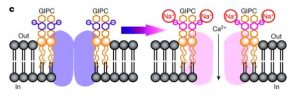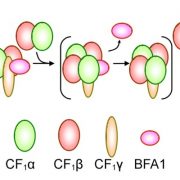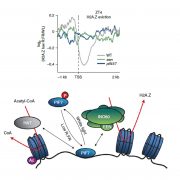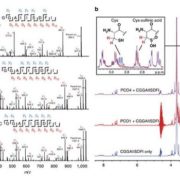Plant cell-surface GIPC sphingolipids sense salt to trigger Ca2+ influx (Nature)
 Soil salinity is one of the most important global problems that negatively affect crop productivity. Jiang et al designed a forward genetic screen in A. thaliana to identify the specific ionic response triggered by salt stress. They mutagenized plants expressing the genetically encoded Ca2+ sensor aequorin, looking at individuals with a reduced NaCl-induced cytosolic Ca2+ concentration. The screen allowed them to analyze the glucuronosyltransferase (IPUT1) for glycosyl inositol phosphorylceramide (GIPC) sphingolipids, MOCA1. The lack of MOCA1/IPUT1 activity not only compromises the salt-induced cytosolic Ca2+ increase but also affects some mechanisms, such as membrane depolarization, and makes plant Na+ sensitive. The authors highlight that MOCA1/IPUT1 is required for the production of GIPC sphingolipids which are present in the plant plasma membrane and are able to bind Na+, supporting a role of sphingolipids in the Na+ sensing in plants. The presence of these lipids let us to hypothesize that the Ca2+ channels should be in the same compartments. Last but not least genetic screens based on “imaging technologies” might represent the standard to discover new genes and proteins involved in important signaling pathways. (Summary by Francesca Resentini) Nature 10.1038/s41586-019-1449-z
Soil salinity is one of the most important global problems that negatively affect crop productivity. Jiang et al designed a forward genetic screen in A. thaliana to identify the specific ionic response triggered by salt stress. They mutagenized plants expressing the genetically encoded Ca2+ sensor aequorin, looking at individuals with a reduced NaCl-induced cytosolic Ca2+ concentration. The screen allowed them to analyze the glucuronosyltransferase (IPUT1) for glycosyl inositol phosphorylceramide (GIPC) sphingolipids, MOCA1. The lack of MOCA1/IPUT1 activity not only compromises the salt-induced cytosolic Ca2+ increase but also affects some mechanisms, such as membrane depolarization, and makes plant Na+ sensitive. The authors highlight that MOCA1/IPUT1 is required for the production of GIPC sphingolipids which are present in the plant plasma membrane and are able to bind Na+, supporting a role of sphingolipids in the Na+ sensing in plants. The presence of these lipids let us to hypothesize that the Ca2+ channels should be in the same compartments. Last but not least genetic screens based on “imaging technologies” might represent the standard to discover new genes and proteins involved in important signaling pathways. (Summary by Francesca Resentini) Nature 10.1038/s41586-019-1449-z









